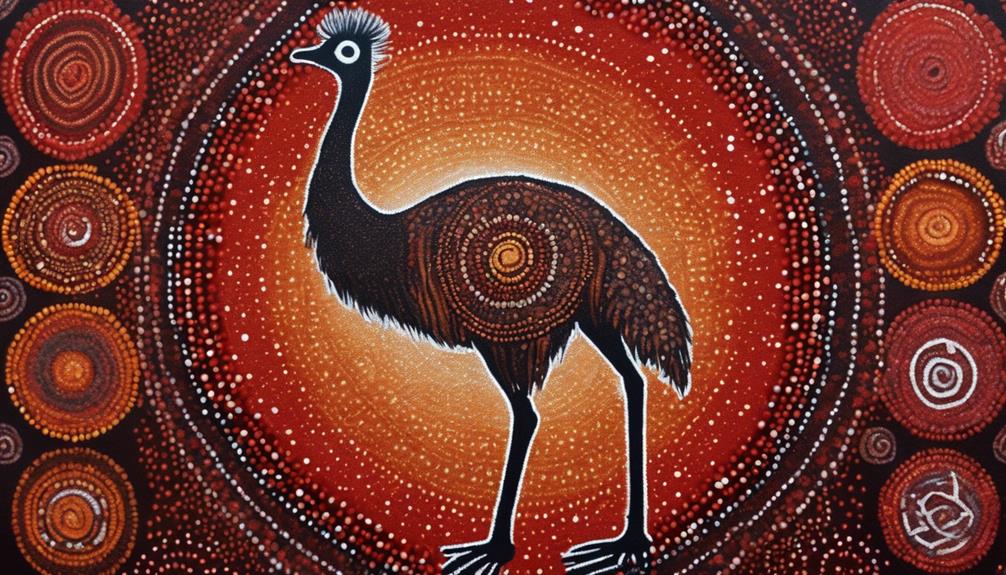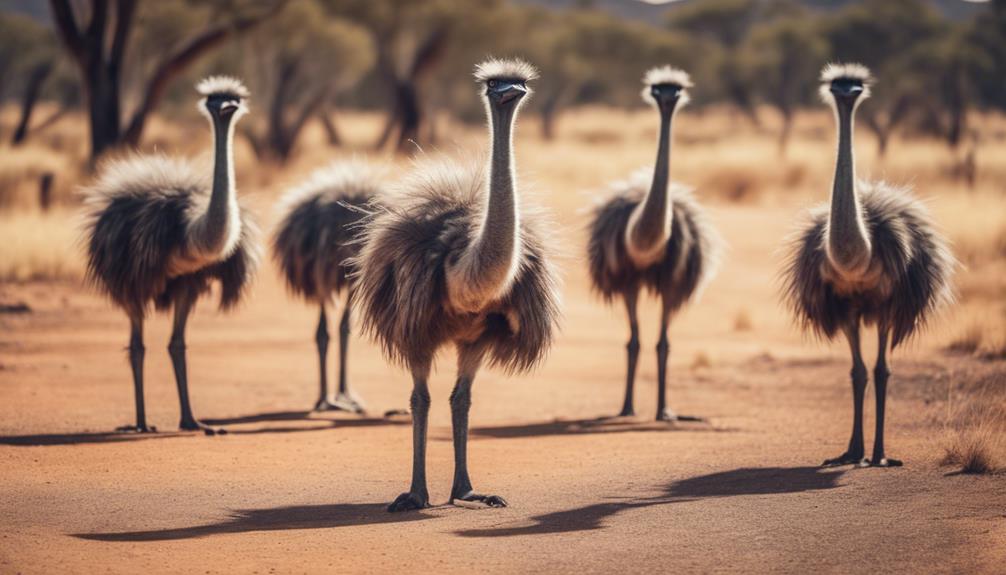Imagine walking through the Australian outback and stumbling upon a group of emus, their distinctive call echoing through the bush. Have you ever wondered about the rich history and significance of these unique creatures in Australia?
From their importance in Indigenous culture to their unexpected role in a historical 'war,' the emu has woven itself into the fabric of the country's identity in surprising ways.
Explore the depths of this iconic bird's past and uncover the mysteries that make the emu a beloved symbol of Australia.
Key Takeaways
- Emus hold cultural significance in Indigenous Australian art and symbolism.
- Historical encounters include early European fascination and the unique Emu War of 1932.
- Emu farming industry offers sustainable practices and diverse products like lean meat and oil.
- Conservation efforts focus on habitat preservation and collaborative initiatives for emu protection.
Indigenous Australian Connection

Indigenous Australians have maintained a deep cultural connection with emus throughout history, emphasizing the bird's significance in their traditions and daily lives. In indigenous art, emus are frequently depicted, symbolizing various aspects of Aboriginal culture. These representations often highlight the emu's importance as a source of food, feathers for ceremonial purposes, and even its role in dreaming stories. The intricate patterns and symbols used in indigenous art reflect the profound spiritual connection that Aboriginal people have with the emu.
The cultural significance of emus goes beyond artistic representations. Emus have been integral to the survival of indigenous communities for centuries. Their meat provided nourishment, their feathers were used in ceremonies, and their behavior often served as a guide for hunting and tracking in the harsh Australian landscape. The deep understanding of emus exhibited by indigenous Australians is a testament to the intricate relationship they've cultivated with these majestic birds over time.
Early European Encounters
Upon arriving in Australia, early European explorers encountered the enigmatic emu, a bird that would soon capture the curiosity and imagination of the newcomers. These initial encounters with the emu left a lasting impression on the European explorers, who were fascinated by the bird's unique appearance and behavior. The emu's cultural significance to the Indigenous Australians was also noted by the early European settlers, leading to a deeper appreciation for this iconic bird.
The early European encounters with the emu were marked by a sense of wonder and intrigue. The explorers observed the emu's large size, distinctive feathers, and agile movements with great interest, documenting their findings in detailed accounts that highlighted the bird's importance to the Australian landscape. As European settlers began to establish themselves in Australia, they recognized the emu's cultural significance to the Indigenous peoples, further solidifying the bird's place in the collective consciousness of the newcomers. The early encounters with the emu laid the foundation for a continued fascination with this majestic creature, shaping its enduring legacy in Australian history.
Emu in Australian Art

In the realm of Australian art, the emu has been a subject of profound inspiration and interpretation for artists across various mediums and styles. Artists have captured the essence of the emu through diverse artistic depictions, reflecting both cultural significance and aesthetic appreciation. Indigenous perspectives play a crucial role in shaping these representations, offering deep insight into the spiritual and symbolic meanings associated with the emu in Aboriginal culture.
Indigenous Perspectives: Aboriginal artists infuse their cultural heritage and spiritual connection to the land into their depictions of emus, highlighting the bird's significance in Dreamtime stories and rituals.
Artistic Depictions in Contemporary Art: Modern artists experiment with different styles and techniques to represent the emu, exploring themes of identity, nature, and sustainability.
Emu Symbolism: The emu symbolizes resilience, strength, and freedom in many artistic interpretations, reflecting its iconic status in Australian art and culture.
Emu War of 1932
During the Emu War of 1932, Australian authorities faced a unique challenge in their attempt to combat the large emu population causing agricultural damage in Western Australia. The military tactics employed to control the emu numbers reflected a fascinating intersection of wildlife management and human conflict resolution strategies.
The authorities, armed with machine guns and led by Major G.P.W. Meredith, set out to cull the emus that were ravaging the wheat crops. However, the elusive nature of the emus and their ability to scatter swiftly made it difficult for the soldiers to effectively reduce the population. The emus, with their agility and speed, outmaneuvered the soldiers, causing the military operation to be largely ineffective.
This event highlighted the complexities of managing wildlife populations through traditional military approaches. It underscored the importance of understanding animal behavior and ecology when devising control measures. Despite the challenges faced during the Emu War, it remains a significant historical example of the intricate dynamics involved in balancing human interests with wildlife conservation efforts.
Emu Feathers in Fashion

The utilization of emu feathers in fashion showcases a unique intersection of cultural tradition, sustainability practices, and artistic expression. Emu feathers have been a part of Indigenous Australian culture for centuries, symbolizing connection to the land and respect for nature. In recent years, the emu feather trade has gained momentum in sustainable fashion trends, promoting ethical sourcing and eco-friendly practices.
- Emu feather trade: The demand for emu feathers in fashion has led to the establishment of ethical supply chains, ensuring that these feathers are sourced responsibly and without harming the emu population.
- Sustainable fashion trends: Designers are incorporating emu feathers into their collections as a way to promote sustainability in the fashion industry, highlighting the beauty and versatility of these natural materials.
- Artistic expression: Emu feathers offer a unique texture and visual appeal, allowing designers to create intricate patterns and designs that reflect the rich cultural heritage associated with these feathers.
Emu Farming Industry
The Emu farming industry plays a crucial role in Australia's economy, contributing to sustainable agricultural practices and biodiversity conservation efforts. Emus are primarily farmed for their meat and oil, both of which have gained popularity for their health benefits and unique properties. Below is a table highlighting the key aspects of the Emu farming industry:
| Aspects | Details |
|---|---|
| Emu Meat | – Lean, red meat high in iron and protein. |
| – Increasing demand for its health benefits. | |
| Emu Oil | – Extracted from fat for skincare products. |
| – Known for its anti-inflammatory properties. |
Emu farming promotes environmental sustainability as these birds require less feed and water compared to traditional livestock. The industry also aids in biodiversity conservation by providing habitat protection for Emus in their natural environment. The growing interest in Emu products not only benefits the economy but also encourages research into sustainable farming practices. Through responsible farming methods, the Emu industry continues to thrive while contributing to the conservation of Australia's iconic bird.
Emu in Contemporary Culture

Exploring the cultural significance of Emus in modern society reveals a fascinating intersection of tradition and contemporary practices. Emus have transcended their natural habitat to become emblematic of Australian culture, with a profound impact on various aspects of contemporary society.
- Emu symbolism in film, television: Emus have been featured in numerous films and television shows, symbolizing strength, resilience, and the unique Australian spirit. Their iconic appearance and distinctive behaviors make them a popular choice for representing the essence of the Australian landscape.
- Emu as national emblem: The Emu holds a special place as one of Australia's national symbols, alongside the Kangaroo. Representing characteristics such as endurance, pride, and freedom, the Emu is deeply ingrained in the country's identity, appearing on various national emblems, coins, and military insignia.
- Emu-inspired art and design: Emus have inspired a wide range of artistic expressions, from paintings and sculptures to fashion designs and architectural elements. Their elegant form and majestic presence continue to captivate artists and designers, shaping contemporary aesthetics with a touch of Australian wilderness.
Emu Conservation Efforts
Amidst mounting environmental concerns and habitat threats, Emu conservation efforts have become pivotal in safeguarding the future of these iconic Australian birds. The preservation of Emu habitat is crucial for ensuring the survival of these flightless birds. Human encroachment, agricultural expansion, and climate change have significantly impacted the areas where Emus thrive, making habitat conservation a top priority for environmental organizations and wildlife authorities.
To highlight the importance of Emu conservation efforts, we can delve into the current status of the Emu population. Understanding population dynamics is essential for implementing effective conservation strategies. By monitoring Emu numbers, distribution patterns, and breeding success rates, researchers can assess the health of the population and identify areas that require intervention.
| Emu Conservation Efforts | |||
|---|---|---|---|
| Habitat Preservation | Population Monitoring | Collaborative Initiatives | |
| Wildlife Corridors | Breeding Programs | Public Awareness Campaigns | |
| Research and Data Analysis |
Emu Behavior and Characteristics

Delving into the intricate behaviors and distinctive characteristics of Emus provides valuable insight into their ecological role and evolutionary adaptations. Emus, known for their curious and sociable nature, exhibit fascinating social interactions within their groups. These interactions often involve vocalizations, body language, and even dancing movements to establish hierarchy and communicate within the flock.
- Mating Rituals: During the breeding season, male emus engage in elaborate courtship displays to attract females. These displays can include puffing up their feathers, emitting deep booming sounds, and performing rhythmic movements to impress potential mates.
- Parental Care: Emus are dedicated parents, with the male taking the primary role in incubating the eggs and rearing the chicks. This behavior is crucial for the survival of the offspring and reflects the strong bond within emu family units.
- Foraging Behavior: Emus are opportunistic feeders, using their sharp beaks to search for a variety of plant materials, insects, and small vertebrates. Their feeding habits play a significant role in shaping the vegetation structure of their habitats.
Emu Symbolism in Australia
Emus, deeply ingrained in Australian culture and history, hold significant symbolism that reflects the country's identity and values. The spiritual significance of emus in Indigenous Australian communities is profound, with these majestic birds often symbolizing freedom, resilience, and strength. In traditional ceremonies, emus play a crucial role, representing connections to the land, ancestors, and the Dreamtime. They're also central to storytelling traditions, where their characteristics and behaviors are used as metaphors to impart important lessons and values to younger generations.
Emus aren't just birds in Australia; they're cultural icons that embody the essence of the land and its people. Their ability to adapt to harsh environments resonates with the Australian spirit of perseverance and survival. Through their representation in art, music, and dance, emus continue to be revered as symbols of wisdom, protection, and longevity in Australian society. The deep-rooted cultural significance of emus underscores their importance in preserving and celebrating the rich heritage of Australia.
Emu in Australian Cuisine

The utilization of emu meat in Australian cuisine has gained recognition for its nutritional value and unique flavor profile, contributing to a diverse culinary landscape. Emu meat, considered a delicacy, is a lean protein source rich in iron, zinc, and omega-3 fatty acids. Its deep red color and slightly gamey taste make it a sought-after ingredient in dishes ranging from gourmet burgers to exotic emu steaks.
- Emu Meat: This lean protein source is a delicacy in Australian cuisine, prized for its nutritional benefits and distinct flavor profile.
- Emu Oil: Extracted from the fat of the emu, this oil is renowned for its various health benefits, including anti-inflammatory properties and skin moisturization.
- Versatile Ingredient: Emu meat's versatility in cooking applications, from grilling to slow cooking, adds a unique touch to traditional recipes and modern culinary creations.
The integration of emu meat and oil in Australian gastronomy showcases the country's rich culinary heritage and the ongoing exploration of novel ingredients for both health and epicurean pleasure.
Emu Tourism and Attractions
Exploring the intersection of emus with tourism reveals a fascinating blend of natural encounters and cultural experiences in Australia. Emu sanctuaries provide a unique opportunity for wildlife encounters, allowing you to observe these majestic birds up close in their natural habitat. These sanctuaries often offer guided tours and educational programs, giving visitors a deeper insight into the emu's behavior and habitat conservation.
On the other hand, emu themed festivals and events celebrate Australia's iconic bird through various activities such as emu racing, art exhibitions, and traditional indigenous performances. These events not only showcase the cultural significance of emus but also provide entertainment for tourists of all ages. Attending an emu festival immerses you in the rich history and folklore surrounding these fascinating creatures, making for a memorable and educational experience.
| Emu Tourism Attractions | Location | Highlights |
|---|---|---|
| Emu Valley Sanctuary | Victoria | Guided tours, feeding sessions |
| Outback Emu Experience | Northern Territory | Emu racing, cultural performances |
| EmuFest | New South Wales | Art exhibitions, live music, food stalls |
Frequently Asked Questions
What Is the Average Lifespan of an Emu in the Wild?
In the wild, emus typically live for around 10 to 20 years. Their behavior is influenced by factors such as habitat conditions and migration patterns. Understanding these aspects can shed light on their longevity in the wild.
Do Emus Migrate to Different Regions Throughout the Year?
Emus, fascinatingly, exhibit unique migration patterns. These iconic birds move due to environmental cues, not seasonal changes. Emu behavior is influenced by factors like food availability and breeding conditions, prompting them to travel to different regions.
How Do Emus Communicate With Each Other?
Emus communicate through a complex system of vocal signals, body language, visual displays, and drumming behavior. Their calls convey various messages, while their movements and postures play a significant role in establishing dominance or signaling aggression within the group.
Are There Any Superstitions or Myths Surrounding Emus in Australian Folklore?
In Australian folklore, emus are steeped in rich symbolism and legends. So much so that they are often portrayed as mystical creatures embodying resilience, wisdom, and even a touch of magic.
Can Emus Be Domesticated as Pets?
Emus display complex behavior patterns and are not typically recommended as pets due to their territorial nature, large size, and specific dietary needs. Emu ownership requires specialized knowledge and resources for their care.
Conclusion
As you reflect on the rich tapestry of history woven by the emus of Australia, you can't help but marvel at their resilience and significance.
Like a majestic brushstroke on a canvas, these iconic birds have left their mark on the cultural landscape of the land down under.
From Indigenous connections to culinary delights, the emu's story is a vivid masterpiece that continues to captivate and intrigue all who encounter it.




